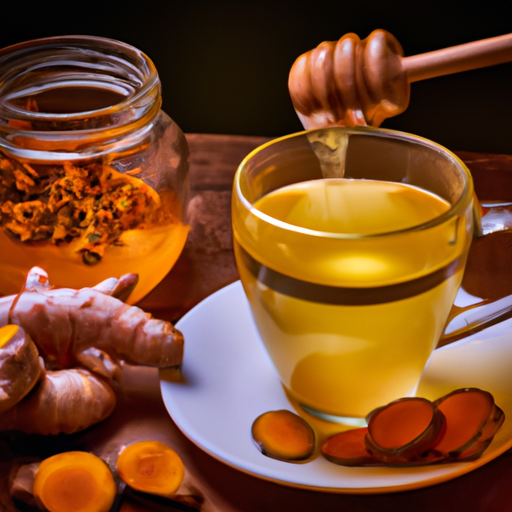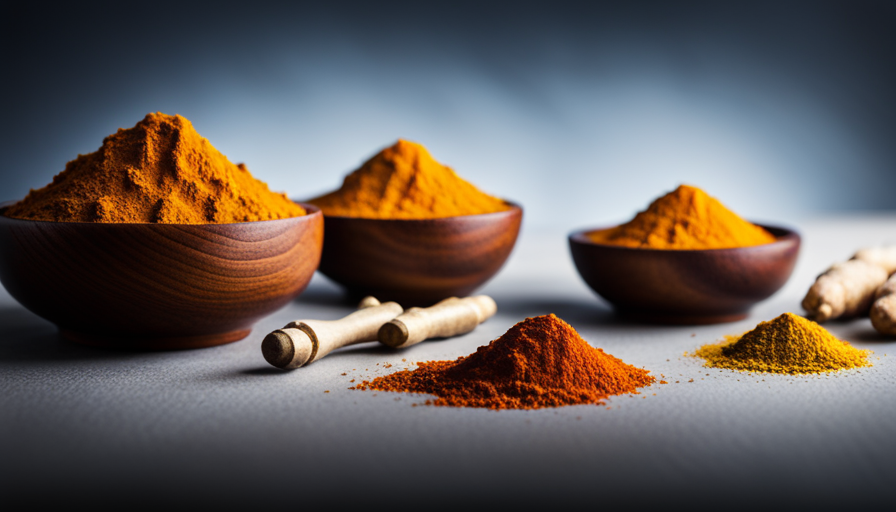Do you want to stop feeling unwell? Maybe you need a natural way to improve your immune system? Look into trying turmeric tea with ginger for some relief.
This simple yet powerful tea has been used for centuries as a natural remedy for various ailments, including inflammation, digestive issues, and even depression. By incorporating turmeric and ginger into your daily routine, you can improve your overall health and well-being.
Not only are these ingredients packed with antioxidants and anti-inflammatory properties, but they also add a delicious flavor to your tea. So, let’s get started on learning how to make the perfect cup of turmeric tea with ginger.
All you need is a few simple ingredients and some basic equipment to get started on your journey to a healthier you.
Key Takeaways
- Turmeric and ginger tea is a natural remedy that offers numerous health benefits due to its antioxidant and anti-inflammatory properties.
- The tea can be made using fresh ingredients like turmeric powder, fresh ginger root, honey, and lemon, and can be customized with different types of ginger, cinnamon, or black pepper.
- Steeping the tea for at least 10 minutes and straining it properly ensures a smooth and consistent texture, while adding sweeteners or milk can enhance the flavor and provide essential nutrients.
- Proper storage of leftover tea in airtight containers in the fridge can help maintain its freshness and flavor, and experimenting with different garnishes can add variety and extra health benefits.
Gather Your Ingredients
Ready to make some delicious turmeric tea with ginger? First, let’s gather our ingredients!
You’ll need turmeric powder, fresh ginger root, water, honey, and lemon. Turmeric is known for its anti-inflammatory and antioxidant properties. It’s been used for centuries as a natural remedy for various ailments, such as arthritis, digestive issues, and skin problems.
Ginger, on the other hand, is a natural anti-inflammatory and immune booster. It can also help relieve nausea and improve digestion. There are different ways to use ginger in tea. You can grate the ginger root and add it directly to the tea, or you can slice it and boil it with the water. You can also use ginger tea bags or ginger powder if you don’t have fresh ginger on hand.
Whichever method you choose, make sure to use fresh ingredients for the best flavor and health benefits. Now that you’ve gathered all your ingredients, it’s time to prepare your equipment for brewing the tea.
Prepare Your Equipment
First, you’ll need to grab a few items to get started. Tea making tips suggest that you use a small saucepan to make turmeric tea with ginger. Using a small saucepan prevents the water from evaporating too quickly and allows for a more concentrated tea. Additionally, you’ll need a strainer to remove any leftover ginger or turmeric bits from the tea. Be sure to use a strainer with small holes to catch any small particles.
Equipment maintenance is also important when making turmeric tea with ginger. Before using your saucepan, make sure it’s clean and free from any leftover food particles. You don’t want any unwanted flavors in your tea! After each use, wash the pan with warm water and soap, then dry it thoroughly. Storing it in a dry place will prevent rust from forming on the surface.
Now that you have your equipment ready, let’s move on to boiling the water.
Boil the Water
To start boiling the water for your deliciously healthy drink, you’ll want to fill your small saucepan with water and place it on the stove over medium-high heat. Boiling water is an essential step in making turmeric tea with ginger as it helps to extract the beneficial compounds from the ingredients.
When boiling the water, keep in mind the benefits of drinking turmeric tea. Turmeric contains a powerful antioxidant called curcumin that has anti-inflammatory properties and can help improve brain function. Adding ginger to the tea can also provide additional health benefits, such as aiding digestion and reducing inflammation. Consider using different types of ginger in your tea, such as fresh ginger root, dried ginger, or ginger tea bags, to add a unique flavor and aroma to your drink.
Now that the water is boiling, it’s time to add the ingredients.
Add the Ingredients
Once the water has reached a rolling boil, simply toss in the chopped up turmeric and ginger and let them simmer for a few minutes until the flavors have melded together and the aroma fills your kitchen – it’ll be an experience you won’t forget! As you wait for the tea to brew, consider adding variations to the recipe to suit your taste. For instance, you can add a cinnamon stick for a warm and sweet flavor or black pepper for a spicy kick. You can also add honey or lemon juice for a touch of sweetness or tanginess.
Aside from its delicious taste, turmeric and ginger tea also offers numerous health benefits. Both turmeric and ginger are known for their anti-inflammatory and antioxidant properties, which can help boost your immune system and reduce inflammation throughout your body. Turmeric has also been shown to improve brain function and lower the risk of heart disease, while ginger can aid in digestion and relieve nausea. With all these benefits, sipping on a cup of turmeric and ginger tea can be a great way to start your day or wind down after a long one. Now, let’s move on to the next step and steep the tea.
Steep the Tea
Now that the flavors have melded together, it’s time for you to steep the fragrant mixture and let its warmth and healing properties envelop you. Steeping the tea is an important step in the process of making turmeric tea with ginger. Before you begin, make sure you have a tea strainer or cheesecloth on hand to filter out any bits of ginger or turmeric.
When steeping the tea, it’s important to let it sit for at least 10 minutes to allow the full benefits of turmeric tea to be released. Turmeric has anti-inflammatory and antioxidant properties that can help boost your immune system and reduce inflammation in the body. You can also experiment with different variations of turmeric tea by adding honey, lemon, or cinnamon to enhance the flavor and health benefits.
Once you’ve let the tea steep to your liking, it’s time to strain the tea and enjoy its warm, comforting goodness.
Strain the Tea
As you pour the fragrant mixture into your favorite mug, the vibrant yellow hue of the turmeric and the spicy aroma of ginger fill the air. Now, it’s time to strain the tea and remove any bits of ginger and turmeric that may have been left behind. Straining techniques may vary, but the goal is to achieve a smooth and consistent texture.
One popular method is to use a fine-mesh strainer or cheesecloth to remove any unwanted particles. Another option is to pour the tea through a tea strainer directly into the mug. Whichever method you choose, be sure to discard the leftover bits and enjoy your hot cup of turmeric tea. Not only does it provide a warm and comforting beverage, but turmeric is also known for its various health benefits, such as reducing inflammation and improving brain function.
Moving on to the next step, if you prefer your tea sweetened or with a splash of milk, now is the time to add it in. Simply stir in your desired amount of honey, agave, or milk to achieve your desired taste.
Add Sweetener and Milk (Optional)
To enhance the flavor of your turmeric beverage, feel free to add a touch of sweetness and a splash of milk according to your personal preference. Here are some options for sweeteners:
- Honey: Known for its anti-inflammatory properties, honey can add a natural sweetness to your turmeric tea while also providing some health benefits.
- Stevia: If you want to avoid sugar, stevia is a great alternative. It’s a natural sweetener that has zero calories and doesn’t raise blood sugar levels.
- Sugar: If you prefer traditional sweeteners, sugar can also be added to taste. However, keep in mind that it’s not as healthy as the other options.
Adding milk is also an optional step that can enhance the taste and nutrition of your turmeric tea. Here are some benefits of adding milk:
- Creaminess: Milk can give your turmeric tea a creamy texture, making it more enjoyable to drink.
- Nutrients: Milk is a good source of calcium, vitamin D, and other nutrients that are essential for your body.
- Digestion: Adding milk can also improve digestion and reduce inflammation in your gut.
Now that you’ve added sweetener and milk (if desired), your turmeric tea is ready to be served and enjoyed.
Serve and Enjoy
Now that you’ve added your sweetener and milk (if desired) to your turmeric tea with ginger, it’s time to serve and enjoy!
Start by carefully pouring your tea into your favorite mug or teacup. To add some extra flair, consider garnishing your tea with a slice of lemon or a sprinkle of cinnamon.
Take a moment to savor the delicious and comforting flavors of your homemade turmeric tea with ginger.
Pouring the tea
When you’re ready to pour the turmeric tea with ginger, gently tilt the kettle and let the aromatic liquid flow into your cup like a golden stream. The way you pour your tea can affect the taste and aroma, and even the health benefits. Different types of teapots require different pouring techniques to enhance the experience. For example, a ceramic teapot requires a steady and slow pour, while a glass teapot should be poured quickly to prevent the tea from becoming too bitter.
To truly elevate your tea drinking experience, consider the benefits of pouring techniques. A slow and steady pour can enhance the aroma and flavor of your tea, while a quick pour can prevent your tea from becoming over-steeped. The table below outlines some different pouring techniques and their benefits. Once you’ve poured your tea, it’s time to garnish it and add some extra flavor to your cup.
| Pouring Technique | Benefit |
|---|---|
| Slow and Steady | Enhances aroma and flavor |
| Quick Pour | Prevents over-steeping |
| High Pour | Aerates the tea for a smoother taste |
| Low Pour | Adds a layer of complexity to the flavor |
Now that you know how to pour your turmeric tea with ginger, let’s move on to the next step: garnishing the tea.
Garnishing the tea
After pouring the fragrant liquid into your cup, it’s time to add a touch of elegance by garnishing your turmeric tea with a few simple ingredients. Decorating tips include adding a slice of lemon or lime for a citrusy twist, a sprig of fresh mint for a refreshing taste, or a cinnamon stick for a warm spice flavor.
Not only do these garnishes add a pop of color, but they also enhance the flavor profile of your turmeric tea. Aside from aesthetic appeal, there are also benefits of garnishing your turmeric tea. Lemon and lime are high in vitamin C and antioxidants, which can boost your immune system and aid in digestion. Mint has been shown to have anti-inflammatory properties, and cinnamon can help regulate blood sugar levels.
So, don’t be afraid to experiment with different garnishes to find your favorite combination. Now, onto storing the leftover tea…
Store Leftover Tea
To keep your leftover turmeric and ginger tea fresh and flavorful, simply store it in the fridge in an airtight container. For example, I always make a big batch of this tea on Sunday and enjoy it throughout the week! When storing the tea, it is important to use the best containers for storing tea. Glass jars or bottles with airtight lids are ideal as they keep the tea fresh and prevent any leaks or spills. Plastic containers may also be used, but they may not be as durable and may transfer unwanted flavors to the tea.
Here is a useful table that provides further information on the best containers for storing tea:
| Container Material | Pros | Cons |
|---|---|---|
| Glass | Does not transfer flavors, easy to clean | Can break easily |
| Stainless Steel | Durable, does not transfer flavors, keeps tea hot or cold | Can be heavy and not see-through |
| Ceramic | Attractive, retains heat well | Can be fragile and porous, may transfer unwanted flavors |
| Plastic | Lightweight, portable, easy to clean | May not be durable, may transfer unwanted flavors |
By using the right container and storing your turmeric and ginger tea properly, you can ensure that it stays fresh and flavorful for days to come. Keep in mind that tea can absorb odors from other foods in the fridge, so it’s best to store it away from strong-smelling items. Enjoy your delicious and healthy turmeric and ginger tea anytime!
Frequently Asked Questions
What are the health benefits of turmeric tea with ginger?
Discover the health benefits of turmeric tea with ginger. This powerful combination is known to reduce inflammation, boost the immune system, improve digestion, and promote overall well-being. Try this easy ginger tea recipe today!
Can turmeric tea with ginger be made without boiling water?
Unfortunately, turmeric tea with ginger requires boiling water to properly infuse the flavors and activate the health benefits. Alternative methods may compromise taste and potency. However, you can experiment with flavor variations like adding honey or lemon.
How long does the tea need to steep for optimal flavor?
For the most flavorful turmeric tea with ginger, steep for at least 10-15 minutes. This optimal steeping time allows the flavors to fully develop. Enhance the flavor profile by adding a splash of honey or a squeeze of lemon. Serve hot or over ice.
Is it necessary to strain the tea before drinking?
To strain or not to strain: the debate on turmeric tea with ginger is ongoing. Some prefer to strain for a smoother texture, while others leave the whole ingredients for a stronger flavor. Experiment with different brewing methods to find your preferred taste.
What is the recommended amount of turmeric and ginger to use in the tea?
To make a healthy and flavorful herbal tea blend, the recommended turmeric-ginger ratio is 2:1. This means using twice the amount of turmeric compared to ginger. Incorporate these ingredients into your tea-making process for optimal health benefits.
Conclusion
Congratulations! You’ve successfully made a cup of turmeric tea with ginger. As you take a sip, feel the warmth spreading through your body. This tea is not only delicious but also packed with health benefits.
Turmeric, with its anti-inflammatory and antioxidant properties, can help reduce inflammation and improve brain function. Ginger, on the other hand, can aid in digestion and relieve nausea.
As you savor every sip, let the goodness of these ingredients heal and nourish you from within. Remember, making turmeric tea with ginger is easy and can be customized to your liking. Experiment with different sweeteners and milk options to find the perfect combination for you.
Don’t forget to store any leftover tea in the fridge for a refreshing iced version later. Enjoy your homemade turmeric tea with ginger and let it be a symbol of self-care and wellness in your life.










